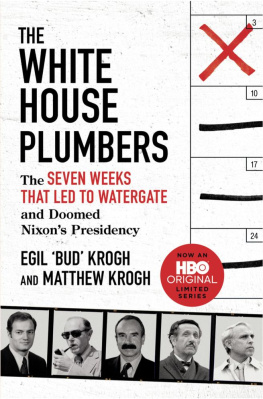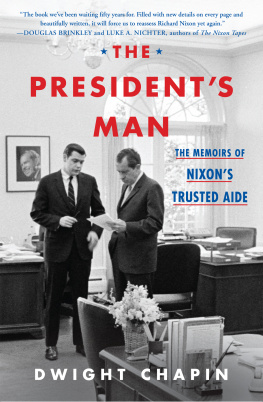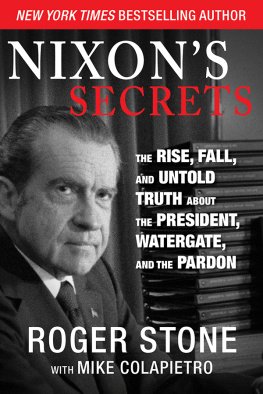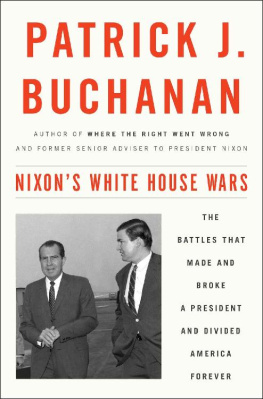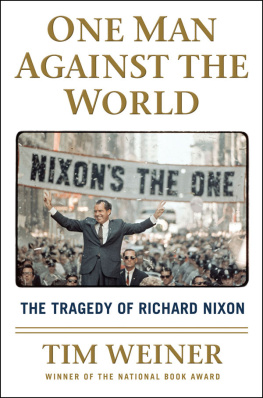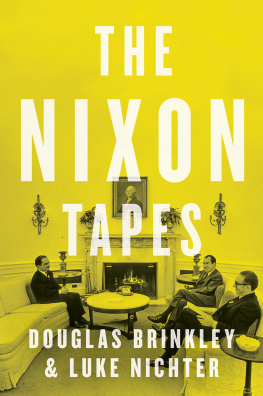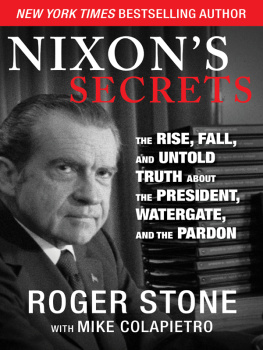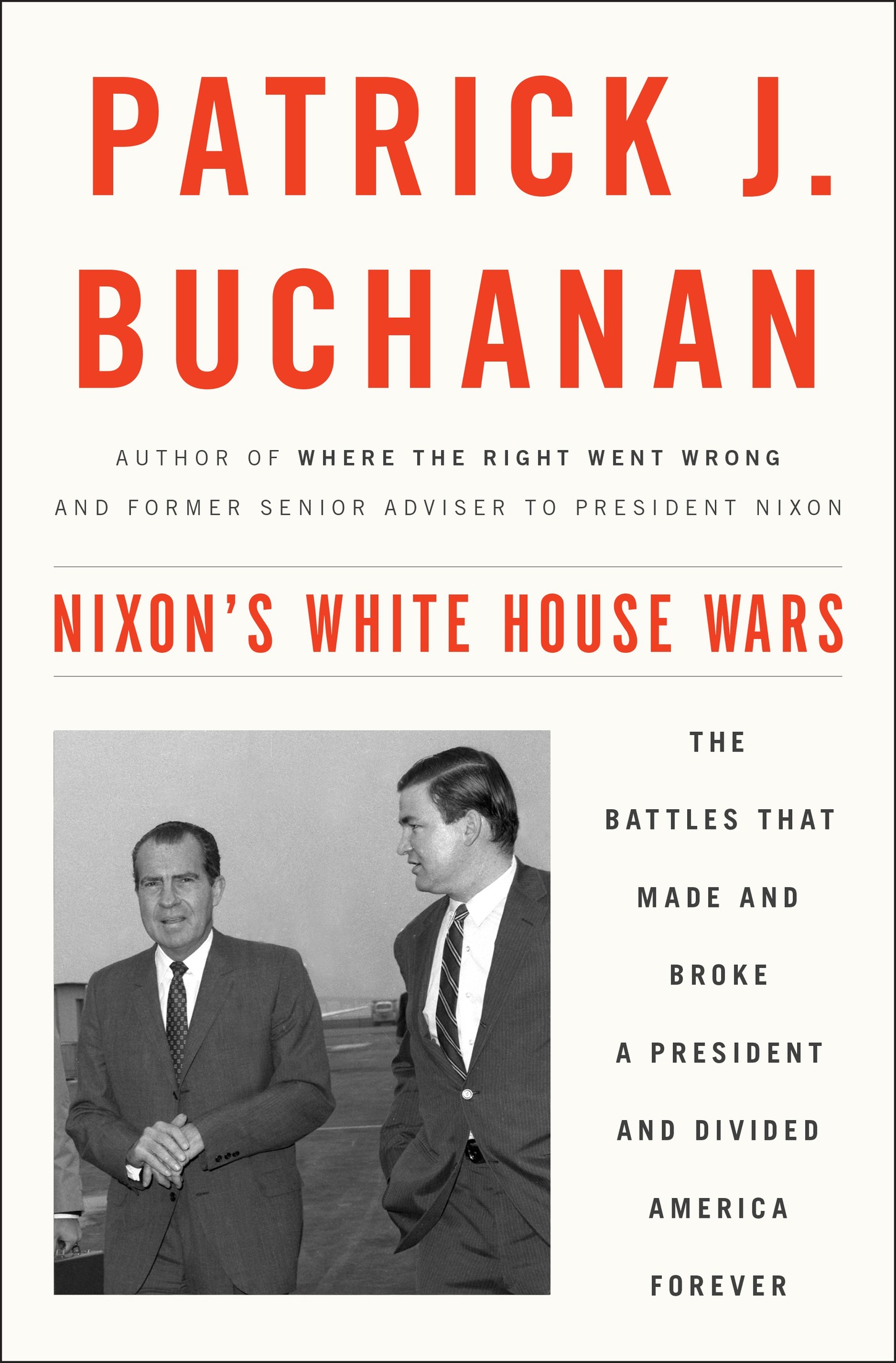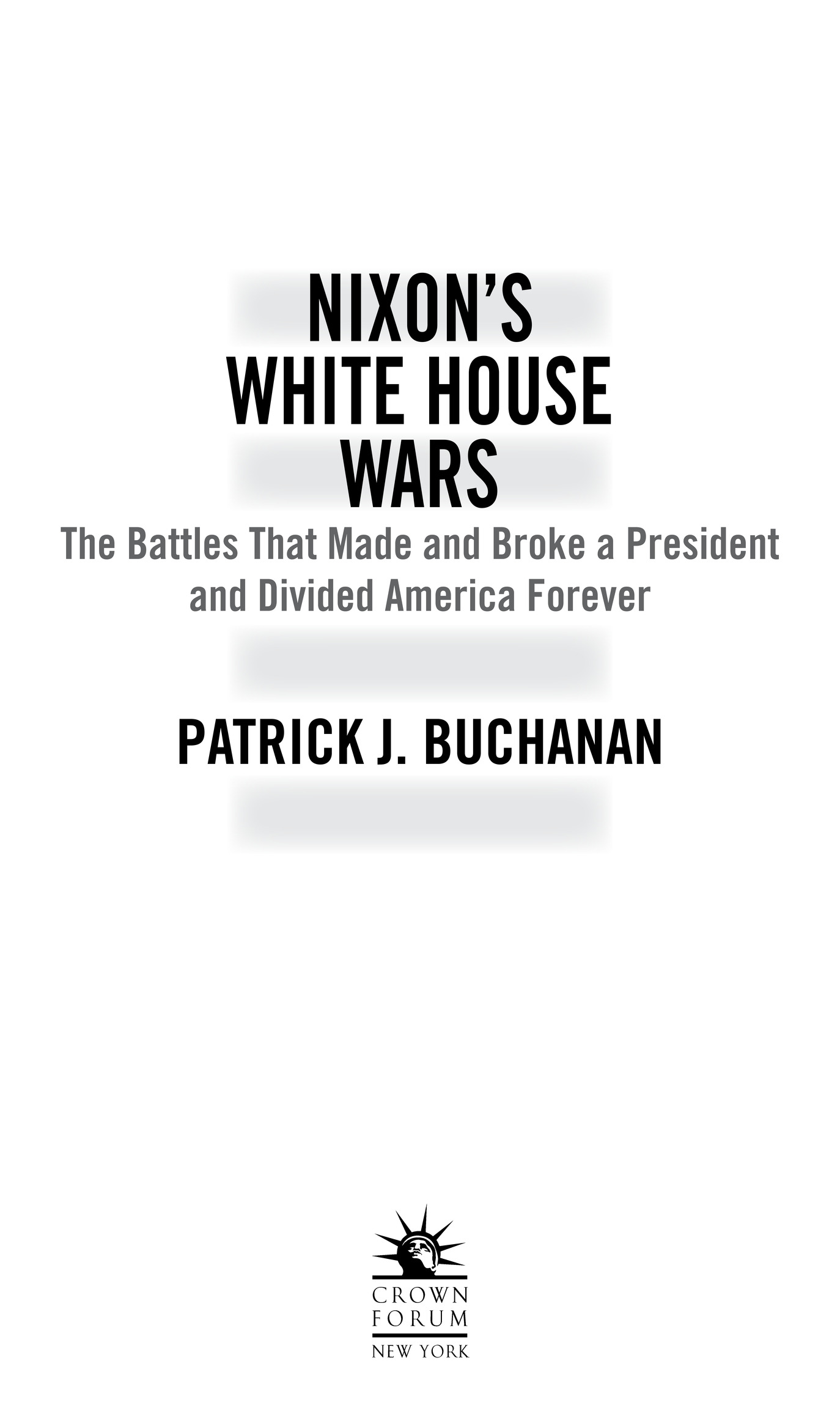ALSO BY PATRICK J. BUCHANAN
The Greatest Comeback
Suicide of a Superpower
Churchill, Hitler, and the Unnecessary War
Day of Reckoning
State of Emergency
Where the Right Went Wrong
The Death of the West
A Republic, Not an Empire
The Great Betrayal
Right from the Beginning
Conservative Votes, Liberal Victories
The New Majority
Copyright 2017 by Patrick J. Buchanan
All rights reserved.
Published in the United States by Crown Forum, an imprint of the Crown Publishing Group, a division of Penguin Random House LLC, New York.
crownforum.com
CROWN FORUM with colophon is a registered trademark of Penguin Random House LLC.
Library of Congress Cataloging-in-Publication Data
Names: Buchanan, Patrick J. (Patrick Joseph), 1938 author.
Title: Nixons White House wars : the battles that made and broke a president and divided America forever / Patrick J. Buchanan.
Description: First edition. | New York : Crown Forum, 2017. | Includes bibliographical references.
Identifiers: LCCN 2016043387 | ISBN 9781101902844 (hardback)
Subjects: LCSH: Nixon, Richard M. (Richard Milhous), 19131994. | Buchanan,
Patrick J. (Patrick Joseph), 1938 | Nixon, Richard M. (Richard Milhous), 19131994Friends and associates. | PresidentsUnited StatesBiography. | Political consultantsUnited StatesBiography. | PresidentsUnited StatesStaffBiography. | SpeechwritersUnited StatesBiography. | Political cultureUnited StatesHistory20th century. | Crisis management in governmentUnited StatesHistory20th century. | United StatesPolitics and government19691974. | BISAC: BIOGRAPHY & AUTOBIOGRAPHY / Presidents & Heads of State. | BIOGRAPHY & AUTOBIOGRAPHY / Political. | HISTORY / United States / 21st Century.
Classification: LCC E856 .B83 2017 | DDC 973.924092 [B]dc23
LC record available at https://lccn.loc.gov/2016043387
ISBN9781101902844
Ebook ISBN9781101902851
Cover design by Alison Forner
Cover photograph: New York Daily News/Getty Images
v4.1
ep
Contents
To Richard Nixon
Theyre a rotten crowd, I shouted across the lawn. Youre worth the whole damn bunch put together.
NICK CARRAWAY TO JAY GATSBY, The Great Gatsby
Wasnt that a time? A time to try the soul of man.
THE WEAVERS
S ix years before Richard Milhous Nixon stood on the East Front of the Capitol to raise his hand on January 20, 1969, not one political observer in a thousand would have predicted he would be there taking the oath as the thirty-seventh President of the United States.
As I wrote in The Greatest Comeback, the political resurrection of Richard Nixon had astonished friends as well as enemies. It had seemed miraculous. Defeated by John F. Kennedy in 1960 in one of the closest races in US history, former vice president Nixon, in November 1962, in the wake of the Cuban Missile Crisis, had been beaten for governor of California by an uncharismatic incumbent named Pat Brown. The morning after, Nixon appeared before the press in Los Angeles and, in the eyes of politicians and journalists alike, committed public political suicide. Exhausted and bitter, Nixon told his tormentors he was through with politics: Think of all the fun youll be missing, he said. You dont have Nixon to kick around anymore, because, gentlemen, this is my last press conference.
That weekend, Howard K. Smith anchored The Political Obituary of Richard M. Nixon, a documentary on ABC that invited Alger Hiss, the Stalinist spy whose treason Nixon had exposed as a member of the House Un-American Activities Committee in 1948, to come spit on Nixons grave.
The backlash against Smith and ABC was ferocious. Many, like the St. Louis Globe-Democrat, where I was a new editorial writer, came to Nixons defense. But that did not change reality. If Nixon, a former congressman and senator from California, and for eight years Vice President to Dwight Eisenhower, could not beat Pat Brown in his own home state, he was not going to be President. His once-brilliant career, the second-youngest Vice President in history, was over. As a national candidate, Nixon was dead.
How, then, did this two-time loser, an Eisenhower Republican loathed by the liberal establishment and press, maneuver through the rapids of the most revolutionary decade of the twentieth century to become President of the United States? To answer the question, we must revisit the history of that most divisive decade since the Civil War.
The civil rights movement had begun in the mid-1950s, with Rosa Parks and the Montgomery Bus Boycott to desegregate public transit, after which came the national shock of Ike sending troops to Little Rock in 1957 to integrate Central High. It progressed through sit-ins at lunch counters and the Freedom Riders in the early 1960s, who sought to desegregate bus travel and bus terminals in the South. Then came the 1963 March on Washington and Dr. Kings I Have a Dream speech, and the Freedom Summer of 1964 to register black voters in Mississippi. That summer the Civil Rights Act was signed by Lyndon Johnson and dedicated to JFK. From 1955 to 1965, America, outside of the South, stood behind the civil rights movement.
But the times they were a-changing. By 1964, Dr. King was being challenged for leadership by Malcolm X, who had split off from the Black Muslims of Elijah Muhammad and would be assassinated in Harlem in early 1965. The Black Power movement arose, and the Black Panthers with their off the pigs slogan. Governor George Wallace of Alabama, who stood in the schoolhouse door in Tuscaloosa, and then had stood aside to allow the university to be integrated, had by 1964 become a backlash candidate challenging Lyndon Johnson for the Democratic nomination and tearing up primaries in Wisconsin, Indiana, and Maryland. Black crime had begun to surge, and the black family to disintegrate. Black America and white America were no longer united. In the Watts area of Los Angeles in the summer of 1965 came the worst racial violence in an American city since the New York draft riots of 1863, when President Lincoln had to send in the veterans of Gettysburg. In July 1967, Newark and Detroit exploded. So extensive were the looting, shooting, and arson, the National Guard was called out and the 82nd Airborne sent in.
In the fall of 1962, after I began writing editorials for the Globe, I was urging US courts to cite segregationist Governor Ross Barnett of Mississippi for contempt for refusing to admit James Meredith to Ole Miss. By 1965, I was writing editorials urging judges to jail civil rights leaders who were violating court orders and occupying a local bank. Protesters were burning our newspapers in trash baskets outside the Globe and chaining our doors shut.
Then there was Vietnam, the most divisive war since the Civil War. Three weeks before Kennedys assassination, South Vietnamese President Ngo Dinh Diem and his brother, the security chief, had been ousted in a military coup. While it may not have been part of the CIA-backed plot, the Diem brothers had been executed inside a US-provided armored personnel carrier. Having overthrown an ally, and put the generals in power, America now owned the war.


